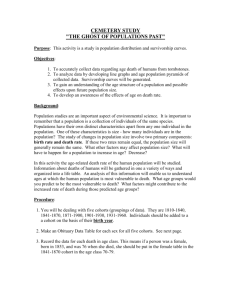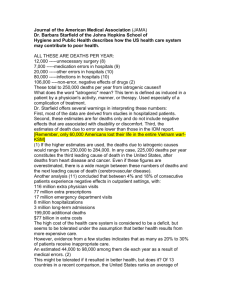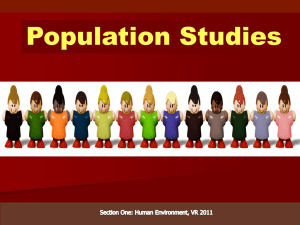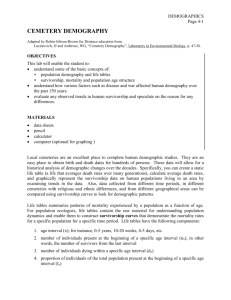Human Populations Studies
advertisement
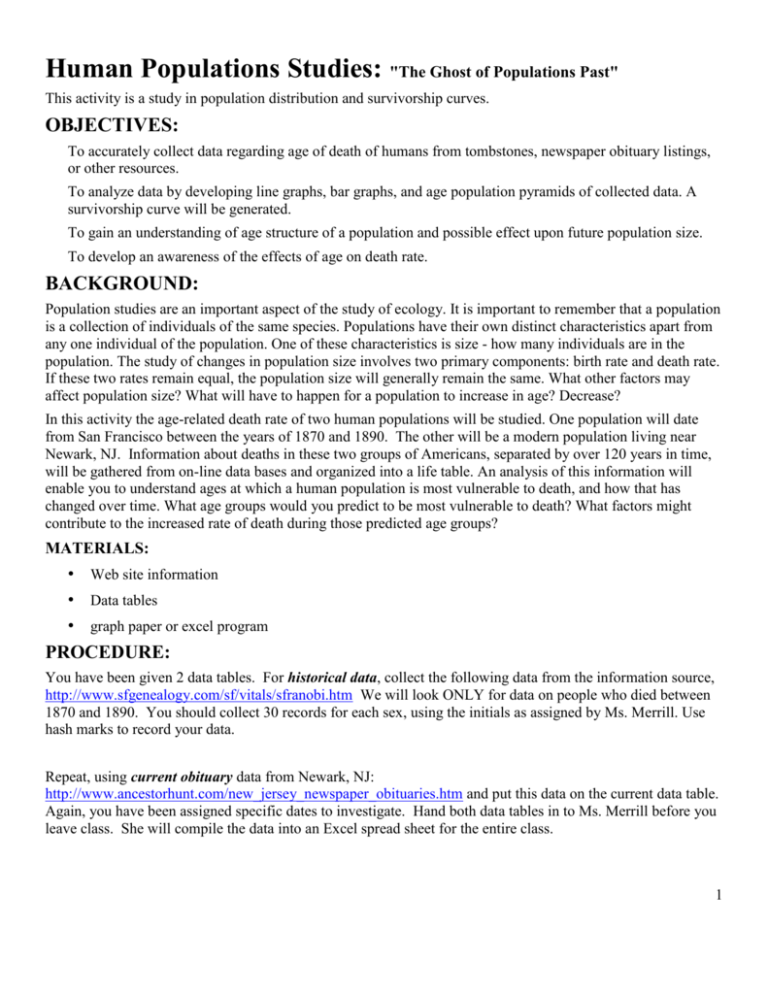
Human Populations Studies: "The Ghost of Populations Past" This activity is a study in population distribution and survivorship curves. OBJECTIVES: To accurately collect data regarding age of death of humans from tombstones, newspaper obituary listings, or other resources. To analyze data by developing line graphs, bar graphs, and age population pyramids of collected data. A survivorship curve will be generated. To gain an understanding of age structure of a population and possible effect upon future population size. To develop an awareness of the effects of age on death rate. BACKGROUND: Population studies are an important aspect of the study of ecology. It is important to remember that a population is a collection of individuals of the same species. Populations have their own distinct characteristics apart from any one individual of the population. One of these characteristics is size - how many individuals are in the population. The study of changes in population size involves two primary components: birth rate and death rate. If these two rates remain equal, the population size will generally remain the same. What other factors may affect population size? What will have to happen for a population to increase in age? Decrease? In this activity the age-related death rate of two human populations will be studied. One population will date from San Francisco between the years of 1870 and 1890. The other will be a modern population living near Newark, NJ. Information about deaths in these two groups of Americans, separated by over 120 years in time, will be gathered from on-line data bases and organized into a life table. An analysis of this information will enable you to understand ages at which a human population is most vulnerable to death, and how that has changed over time. What age groups would you predict to be most vulnerable to death? What factors might contribute to the increased rate of death during those predicted age groups? MATERIALS: • Web site information • Data tables • graph paper or excel program PROCEDURE: You have been given 2 data tables. For historical data, collect the following data from the information source, http://www.sfgenealogy.com/sf/vitals/sfranobi.htm We will look ONLY for data on people who died between 1870 and 1890. You should collect 30 records for each sex, using the initials as assigned by Ms. Merrill. Use hash marks to record your data. Repeat, using current obituary data from Newark, NJ: http://www.ancestorhunt.com/new_jersey_newspaper_obituaries.htm and put this data on the current data table. Again, you have been assigned specific dates to investigate. Hand both data tables in to Ms. Merrill before you leave class. She will compile the data into an Excel spread sheet for the entire class. 1 ANALYSIS: One half of your team will work on the historical data set, the other on the modern-day data set. Excel can be used to produce these graphs, but unless you are an excel expert, you will be faster with pencil and paper!. You need to construct the following graphs for each population. 1. Follow instruction in Molnar, page 151 steps 4-7. First, out either the historical Life Table or the Current Life table, working in pairs following the method in steps 3 and 4, using the class data for your population provided by your teacher.. Partners should check with each other to confirm their calculations are correct after you have done this. 2. Graph mortality Rates, as outlined in steps 5-7 in Molnar. Be sure to put males and females on the same graph. Your team will produce 2 graphs, one for the historical population and one for the current population. Be sure to use the same scales for each graph so that they can be easily compared. 3. Producing Age-Sex diagrams (population pyramids). Follow the instructions in Molnar on page 158 for this. Remember that we used 10-year intervals rather than 5-year ingervals, so your graphs will have fewer entries on the y-axis. 4. Survivorship curve like the one on page 149 in Molnar. Obain a piece of semi-log graph paper, and label the axes as demonstrated by your teacher. Plot the total surviving (y, log scale) vs the age group (x, arithmetic scale). By connecting your points in a smooth curve, you should get a graph similar to the one on page 149. Draw both male and female lines on the same graph. Discussion: 1. What type of country does your historical population pryamid most resemble? Developed country? Developing country? Is there any difference between the male and female sides? What conclusions could you draw about your population based on your pryamid? How about your current data? 2. Discuss your mortality curves, especially any differences you see between males and females for both populations, and try to explain any differences you see. 3. Comment on the likely situation for employment and education of women in the US for the two time periodstime period you studied. 4. How do life insurance companies use such data as we have collected? 2 Class data: Historical Life Table Males Age Number of deaths Females Total Surviving Mortality rate Number of deaths Total Surviving Mortality rate 100 + 90-99 80-89 70-79 60-69 50-59 40-49 30-39 20-29 10-19 0-9 Follow instructions in Molnar, page 151 steps 4-7. 3 Class data: Current Life Table Males Age Number of deaths Females Total Surviving Mortality rate Number of deaths Total Surviving Mortality rate 100 + 90-99 80-89 70-79 60-69 50-59 40-49 30-39 20-29 10-19 0-9 Follow instructions in Molnar, page 151 steps 4-7. 4 Data collection Data sheets for each student: Make a tally mark for each male or female death you record. Make sure that you have 30 males and 30 females for each data set! Historical Data: Age at Death 100 + 90-99 80-89 70-79 60-69 50-59 40-49 30-39 20-29 10-19 0-9 Male Current Data: Female Age at Death Male Female 100 + 90-99 80-89 70-79 60-69 50-59 40-49 30-39 20-29 10-19 0-9 5

